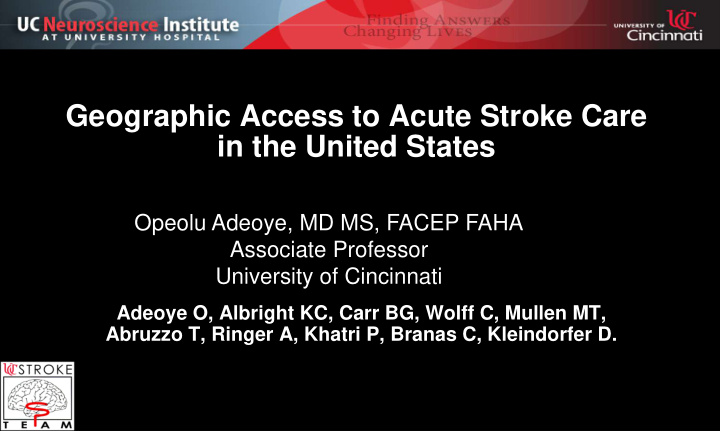



Geographic Access to Acute Stroke Care in the United States Opeolu Adeoye, MD MS, FACEP FAHA Associate Professor University of Cincinnati Adeoye O, Albright KC, Carr BG, Wolff C, Mullen MT, Abruzzo T, Ringer A, Khatri P, Branas C, Kleindorfer D.
Disclosures Research/Salary – NIH/NINDS – OA, KCA, BC, MM, PK, CB, DK Research/Salary – Genentech – PK Research/Salary – Penumbra – PK Speakers’ Bureau – Genentech – DK
Acknowledgments – CDC/AHRQ Adeoye O 1-3 , Albright KC 4 , Carr BG 5,6 , Wolff C 5 , Mullen MT 7 , Abruzzo T 1,3 , Ringer A 1,3 , Khatri P 1,8 , Branas C 5 , Kleindorfer D 1,8 . Affiliations: 1. University of Cincinnati Neuroscience Institute, Cincinnati, OH 2. Department of Emergency Medicine, University of Cincinnati, Cincinnati, OH 3. Department of Neurosurgery, University of Cincinnati, Cincinnati, OH 4. Department of Neurology, University of Alabama at Birmingham, Birmingham, AL 5. Department of Biostatistics and Epidemiology, University of Pennsylvania 6. Department of Emergency Medicine, University of Pennsylvania 7. Department of Neurology, University of Pennsylvania 8. Department of Neurology, University of Cincinnati, Cincinnati, OH
Background Only 3-5% of acute ischemic stroke (AIS) patients receive intravenous (IV) recombinant tissue plasminogen activator (rt-PA) Less than 1% receive endovascular therapy Adeoye Stroke 2011; Hassan Stroke 2012
Background The ASA recommends designation of Acute Stroke Ready Hospitals (ASRH), Primary Stroke Centers (PSC) and Comprehensive Stroke Centers (CSC) PSC certified hospitals are more likely to treat AIS patients with rt-PA and treatment at designated stroke centers is associated with lower 30-day mortality Alberts JAMA 2000; Mullen JAHA 2013
Background Goal - inform planning for stroke certification for US hospitals Describe access of the US population to all hospitals that actually deliver acute stroke care (IV and endovascular therapy)
Methods - Medicare Provider and Analysis Review (MEDPAR) A claims-based dataset that contains every fee-for-service Medicare-eligible hospital discharge in the US Fiscal year 2011 data were used
Methods - Medicare Provider and Analysis Review (MEDPAR) Acute ischemic stroke primary discharge diagnosis ICD-9 codes: – 433.xx (occlusion and stenosis of precerebral arteries) – 434.xx (occlusion of cerebral arteries) – 436 (acute, but ill-defined, cerebrovascular disease)
Methods - Medicare Provider and Analysis Review (MEDPAR) Among ICD-9 codes 433, 434 and 436: – Patients receiving IV thrombolysis were identified using ICD-9 code 99.10 (thrombolytic use) – Patients receiving endovascular therapy were identified by ICD-9 code 39.74 (endovascular removal of obstruction from head and neck vessels) – Hospitals that gave a single dose of rt-PA or performed a single thrombectomy procedure were considered capable
Methods – Population Data 2010 Neilsen Claritas Census Estimations Rely on a regularly refined and validated projection methodology based on the most recent decennial Census data
Methods – Access Calculations Block groups, or subdivisions within Census tracts, of 600 to 3000 people were used as the primary geographic unit for analysis A population-weighted center point (centroid) was assigned within each block group
Methods – Access Calculations The shortest road distance was determined between each block group centroid and each hospital Distances were converted to total prehospital ambulance transport times Travel times were computed based on posted speed limits for roads in each path
Results 370,351 AIS primary diagnosis discharges – 14,926 (4%) received IV rt-PA – 1,889 (0.5%) received endovascular therapy 4,583 acute care hospitals in MEDPAR – 2,895 (63%) did not give any doses of IV rt-PA – 4,252 (93%) did not perform thrombectomy – 327 (7%) hospitals gave at least one dose of IV rt-PA and performed at least one thrombectomy
Results The 327 hospitals that gave at least one dose of rt-PA and performed one thrombectomy procedure discharged approximately 28% of all AIS cases Hospitals that did not give any doses of IV rt-PA discharged 17% of all AIS cases
Results - Access By ground: – 81% percent of the US population had 60-minute access to IV rt-PA capable hospitals – 66% had access to PSCs – 56% had access to endovascular capable hospitals
Results - Access By air: – 97% percent had 60-minute access to IV capable hospitals – 91% had access to PSCs – 85% had access to endovascular capable hospitals
Discussion Despite adequate geographic access, acute stroke treatment rates in the US remain extremely low These data should inform the planning and optimization of stroke systems in the US
Discussion Given that one in five US stroke discharges were from hospitals that did not give any rt-PA, there’s much room for improvement in the current US system of stroke triage
Limitations Calculations reflect potential access and not true access Use of an administrative dataset to estimate rt-PA and endovascular thrombectomy treatment rates Reliability of rt-PA and thrombectomy ICD-9 codes PSC designation is a continually evolving process
Conclusion To reduce time from symptom onset to an acute stroke capable hospital: − Public education to ensure 911 called − EMS should transport quickly to appropriate hospital − Hospitals that do not provide acute stroke care should have plans in place to facilitate rapid evaluation and treatment by stroke experts
Conclusion Monitoring and reporting of regional stroke outcomes could help to incentivize hospitals and prehospital systems to work together to collaboratively facilitate acute stroke care.
Addendum PSCs were hospitals designated as such as of December 2010 Of the 327 hospitals, 278 (85%) were PSCs Of 821 PSCs, 93% administered at least one dose of IV rt-PA; 23% of non-PSCs administered at least one dose of IV rt-PA. Thirty three percent of PSCs performed at least one thrombectomy while 1.5% of non- PSCs performed at least one thrombectomy procedure.
Addendum Crossing state lines was allowed in access calculations Time to scene and time from scene to hospital were calculated using Euclidian distances
Recommend
More recommend